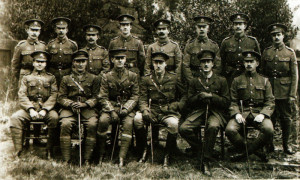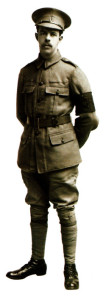
Formed around 1915, the Volunteer Training Corps (later the Volunteer Battalion, Isle of Wight Regiment) was a forerunner of the Home Guard. In it my father was a corporal. Their first uniform was field grey with a red brassard bearing the letters ‘G.R’. I still have the brassard and a shoulder badge with the word ‘Cowes’ surmounted by ‘V.T.C.’ in brass capitals. Later the grey was replaced by khaki. In those days puttees were worn, and sometimes father wound and unwound a dozen times before achieving the desired effect. His uniform fitted, and his Kitchener- type moustache gave a final touch to his military appearance.
From the outset he took a great interest in the Corps, and from time to time drilling and signalling manuals found their way home. Although I never knew the morse code thoroughly, I learned the semaphore alphabet with ease, and soon became adept with two small red and yellow flags. Once I was called uppon to show my prowess to a visitor, who gave me half a crown.
The venue for most of the V.T.C’s training was the Cowes Drill Hall, where a sergeant from the ‘regulars’ presided. He had, apparently, the pungent volubility of his kind, for I remember my father’s amusement after hearing of some of his unflattering similes. This warrior also taught them bayonet drill, an exercise in which perhaps more than anything else, brought home the ugly realities that lay behind what they were so light-heartedly doing.

In less bloodthirsty moments an officer gave lessons in French, in consequence of which I could be heard repeating “Je ne sais pas”, referring to “Mon chapeau”, and uttering other snippets – the start of an interest that later opened for me the covers of Honore de Balzac and others.
From the windows of my bungalow I can look across the road to the place patrolled by my father during his spells of guard duty. The buildings are new, Hitler’s bombs having destroyed the original hangars of Somerton Aerodrome in 1942, when they made my home uninhabitable.
Occasionally a bull would turn on the Aerodrome. To hear it snorting and pawing in the vicinity of one’s beat, and to be unable to see it, was an unenviable experience. A ‘brass hat’ from Albany Barracks who arrived unexpectedly complimented my father for being the only sentry who knew his duty he’d met that night. I, too, knew it by heart, and at the age of seven could recite precepts which forbade loitering on or near the post, and prescribed that the sentinel conduct himself in a smart and soldierly manner. I could also challenge a stranger, call out the guard, slope, trail or present arms, and generally behave like an authentic Tommy Atkins.
Weekends were occupied with route marches, musketry, and manoeuvres. During one of the latter my father gained another distinction – that of nearly losing his life. It happened when they were being taught to make grenades from cigarette tins, and throw them (after the neccessary time lag) into the enemy’s trenches. All went well until one man accidentally lobbed his bomb in the wrong direction. It struck the ground, exploded and sent a jagged piece of metal straight at corporal T.W.Hudson’s head.
Instinctively he turned away, and the fragment caught him a glancing blow behind an ear, making a nasty gash. Had he been only one step nearer the explosion, the situation might easily have called for reversed arms and the The Last Post.
C’est la guerre!
T. C. Hudson








